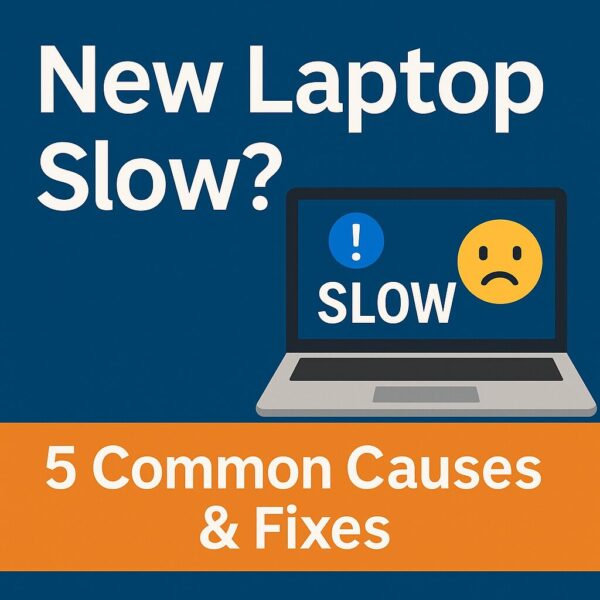
Did your brand-new laptop feel slow right after unboxing it? You’re not alone. Even in 2025, many users are surprised to find that a fresh Windows 11 device feels laggy, takes too long to start apps, or freezes during simple tasks.
The good news: in most cases, your PC is not “broken.” It’s usually a mix of pre-installed software, background setup tasks, power settings, or entry-level hardware choices. In this guide, we’ll walk through the most common causes of a slow new laptop and what you can do to fix them—step by step, with beginner-friendly tips and no special tools required.
Common Reasons a New Laptop Feels Slow (and How to Fix Them)
Cause 1: Pre-installed bloatware and trial software
Most new Windows laptops ship with extra software you never asked for: trial antivirus, manufacturer utilities, cloud backup trials, “PC cleaner” tools, and more. Many of these apps start automatically with Windows and quietly consume CPU, memory, and internet bandwidth.
Fix: Remove the apps you don’t need.
- Open
Settings → Apps → Installed apps(Windows 11). - Sort by Install date or Name and look for trial antivirus, OEM “assistant” tools, and unnecessary bundles.
- Click … → Uninstall for apps you don’t plan to use.
Tip: Trial antivirus suites often slow down new laptops with aggressive scans and popups. If you plan to use Windows Security (built-in) or another antivirus, uninstall the pre-installed one first to avoid conflicts.
Cause 2: Background updates, setup tasks, and indexing
Right after the first boot, Windows 11 is busy in the background: downloading updates, installing drivers, syncing your Microsoft account, and indexing files so search works faster later. During this time, the laptop can feel slow, the fan may run loudly, and the disk/SSD may stay at 100% usage.
Fix: Give Windows a little time to finish its first-time tasks.
- After completing the initial setup, restart once.
- Leave the laptop idle (plugged in, screen on or set to stay awake) for 20–30 minutes so updates and indexing can complete.
- Press Ctrl + Shift + Esc to open Task Manager and check the CPU and Disk columns—if they’re close to 100% with “Windows Installer,” “Antimalware Service,” or “Indexer” running, it’s likely temporary.
Tip: Running heavy apps (like games, large downloads, or Office installs) while Windows is still installing updates can make everything feel slower. Let Windows finish first if possible.
Cause 3: Power-saving or “quiet” performance mode
To maximize battery life and reduce fan noise, many laptops ship in a conservative power mode. This reduces CPU performance and can make the system feel sluggish when you open apps, browse the web, or join video calls.
Fix: Switch to a performance-oriented power mode, especially when plugged in.
- Go to
Settings → System → Power & battery. - Under Power mode, choose Best performance (or at least Balanced).
- If your laptop has a brand utility (Lenovo Vantage, Dell Power Manager, HP Command Center, ASUS Armoury Crate, etc.), check there for Performance or AC mode profiles.
Note: Using “Best performance” will use more power and may reduce battery life, but it’s often worth it when you’re connected to AC power.
Cause 4: Entry-level CPU or low memory (RAM)
Some budget laptops use low-power processors (for example, Intel N-series, older Celeron/Pentium, or low-end mobile CPUs) and only 4 GB of RAM. While this is enough for very light tasks, it can feel slow if you:
- Open many browser tabs
- Run Office apps and video calls at the same time
- Use heavy websites or cloud tools
Fix (short term): Close unused apps and tabs.
- Check Task Manager → Memory to see if RAM usage is near 100%.
- Close apps you’re not actively using (especially browsers with many tabs, chat apps, and game launchers).
Fix (long term): If your laptop allows it, consider upgrading to 8 GB or 16 GB of RAM. Unfortunately, some thin-and-light models have RAM soldered to the motherboard and cannot be upgraded—check the manufacturer’s specs for your model.
Cause 5: Slow SSD, eMMC storage, or nearly full system drive
Not all “SSDs” are created equal. Some entry-level laptops use slower SSDs or eMMC storage, which can make tasks like app installation, Windows updates, and file transfers feel sluggish. A nearly full C: drive can also slow things down.
Fix: Keep free space available and avoid overloading the system drive.
- Open
Settings → System → Storageand make sure your C: drive has at least 20–30% free space. - Turn on Storage Sense to automatically delete temporary files and empty the Recycle Bin.
- Move large game libraries, videos, and photo archives to an external drive or secondary internal drive if available.
This article contains affiliate links. If you purchase through them, we may earn a small commission at no additional cost to you. Thank you for your support!
Bonus Tip: Use the built-in cleanup tools in Windows 11. Go to Settings → System → Storage → Temporary files and remove old temporary files, previous Windows installation files (if any), and other unneeded items.
Summary: Quick Checklist for a Slow New Laptop
| Check Item | Suggested Action |
|---|---|
| Unwanted apps / trials | Uninstall from Settings → Apps |
| Background updates | Let Windows finish updates and indexing, then restart |
| Power mode | Set to Best performance when plugged in |
| Memory (RAM) | Close unused apps; consider upgrading if possible |
| Storage / SSD | Keep 20–30% free space; use Storage Sense |
Optional: Extra Tools and Settings to Speed Things Up
If your laptop still feels slow after the basics, try these additional steps:
- Update drivers and firmware: Go to
Settings → Windows Updateand install all important updates. Also check your laptop manufacturer’s support page for BIOS or driver updates. - Run Windows troubleshooters: Go to
Settings → System → Troubleshoot → Other troubleshootersand run tools like Internet Connections or Power if relevant. - Use “Disk Cleanup” or “Storage Sense”: Remove temporary files, old Windows installations, and thumbnail caches that may take up space.
- Disable apps that start with Windows: In Task Manager → Startup apps, turn off anything you don’t need at boot.
Final Thoughts
A new laptop should feel responsive and enjoyable to use. If it feels slow from day one, it’s usually due to background tasks, conservative power settings, pre-installed software, or entry-level hardware—not because you did something wrong.
By removing bloatware, letting Windows finish its first updates, adjusting power mode, and checking your storage and memory, you can often transform a “disappointing” new PC into a smooth daily driver. If performance is still not where you want it to be, an SSD or RAM upgrade (when possible) is one of the most effective long-term improvements you can make.
We hope this guide was helpful! For more beginner-friendly PC tips, check out our other troubleshooting articles:

![Unlock Windows God Mode: Access All Settings in One Place [2025 Guide]](https://kimiyoya.com/wp-content/uploads/2025/08/1B91E871-B93E-4BFD-9916-32570A28A405-375x375.jpg)
